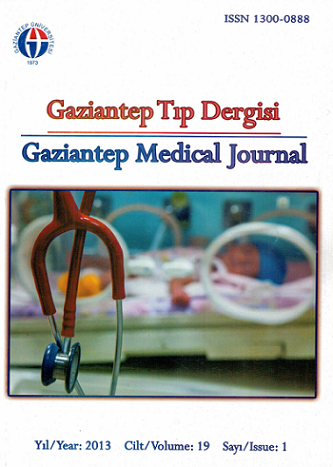Comparison of 4% icodextrin and auto-crosslinked hyaluronic acid gel in terms of efficacy and cost effectivity in preventing postoperative abdominal adhesions
DOI:
https://doi.org/10.5455/GMJ-30-2012-119Keywords:
Adhesion, costs, hyaluronic acid, icodextrinAbstract
This experimental study was designed to compare the effects and costs of 4% icodextrin and hyaluronic acid in intraabdominal adhesion formation in rats. This study included 30 healthy Wistar albino rats, each weighing 250-300 gr. Following cecal-ileal abrasion to rats in each group, the following treatments were applied: Group 1 (control, n:10) 5 ml saline irrigation; Group 2 (n:10) 5 ml 4% icodextrin solution; Group 3 (n:10) 3 ml auto-crosslinked hyaluronic acid gel. After 14 days, following a second operation, adhesion intensity scoring, histopathological assessment (inflammation, fibrosis) and costs were compared between groups. The lowest postoperative adhesion intensity score was found in the group 3 and the highest score was found in the group 1 (p=0.028). Group 3 had a non-significantly lower adhesion intensity score than group 2 (p>0.05). In terms of inflammation and fibrosis, group 2 had the lowest score, but there were no significant differences between all the groups (p>0.05). In terms of cost, 4% icodextrin is less expensive than hyaluronic acid. The results demonstrated that both hyaluronic acid and 4% icodextrin are similarly effective in reducing postoperative intraabdominal adhesions. In addition, 4% icodextrin is more cost-effective, which can be an advantage for clinical studies.
Metrics
References
Li TC, Cooke ID. The value of an absorbable adhesions barier, interceed in the prevention of adhesions reformation following microsurgical adhesiolysis. Br J Obstet Gynaecol 1994;101:335-9.
Liakakos T, Thomakos N, Fine PM, Dervenis C, Young RL. Peritoneal adhesions: etiology, pathophysiology, and clinical significance. Dig Surg 2001;18:260-73.
Hye SA, Hyuk JL, Moon WY, Sang HJ, Tae SH, Woo HK and et al. Efficacy of an injectable thermosensitive gel on postoperative adhesion in rat model. J Korean Surg Soc 2010; 79: 239-245.
Mais V, Bracco GL, Litta P, Gargiulo T, Melis GB. Reduction of postoperative adhesions with an auto-crosslinked hyaluronan gel in gynaecological laparoscopic surgery: a blinded, controlled, randomized, multicentre study. Hum Reprod. 2006;21:1248-54.
Becker JM, Dayton MT, Fazio VW, Beck DE, Stryker SJ, Wexner SD, et al. Prevention of postoperative abdominal adhesions by a sodium hyalurinate-based bioresorbable membrane: a prospective, randomized, double-blind multicenter study. J Am Coll Surg 1996;183:297-306.
Salum MR, Lam DT, Wexner SD, Pikarsky A, Baig MK, Weiss EG, et al. Does limited placement of bioresorbable membrane of modified sodium hyaluronate and carboxymetylcellulose (Seprafilm®) have possible short-term beneficial impact? Dis Colon Rectum. 2001;44:706-12.
Guida M, Acunzo G, Di Spiezio Sardo A, Bifulco G, Piccoli R, Pellicano M, et al. Effectiveness of auto-crosslinked hyaluronic acid gel in the prevention of intrauterine adhesions after hysteroscopic surgery: a prospective, randomized, controlled study. Hum Reprod 2004;19:1461-1464.
Shamiyehı A, Danis J, Benkö L, Vattay P, Röth E, Tulipan L, et al. Effect of hyaluron derivate gel in prevention of postsurgical peritoneal adhesions-an experimental study in pigs. Hepatogastroenterology 2007;54:1121-4.
Binda MM, Koninckx PR. Hyperoxia and prevention of adhesion formation: a laparoscopic mouse model for open surgery. BJOG 2010;117:331-9.
Binda MM, Koninckx PR. Prevention of adhesion formation in a laparoscopic mouse model should combine local treatment with peritoneal cavity conditioning. Hum Reprod 2009;24:1473-9.
Brown CB, Lucianao AA, Martin D, Peers E, Scrimgeour A, diZerega GS; Adept Adhesion Reduction Group. Adept (icodextrin 4% solution) reduces adhesions after laparoscopic surgery for adhesiolysis: a double-blind, randomized, controlled study. Fertil Steril 2007;88:1413-26.
Menzies D, Pascual MH, Walz MK, Duron JJ, Tonelli F, Crowe A, et al. Use of icodextrin 4% solution in the prevention of adhesion formation fallowing general surgery: from the multicentre ARIEL Registry. Ann R Coll Surg Engl 2006;88:375-82.
Kössi J, Grönlund S, Uotila-Nieminen M, Crowe A, Knight A, Keranen U. The effect of 4% icodextrin solution on adhesiolysis surgery time at the Hartmann's reversal: a pilot, multicentre, randomized control trial vs lactaded Ringer's solution Colorectal Dis. 2009;11:168-72.
Müller SA, Treutner KH, Anurov M, Titkova S, Oettinger AP, Schumpelick V. Experimental evaluation of phospholipids and icodextrin in re-formation of peritoneal adhesions. Br J Surg 2003;90:1604-7.
Baca B, Boler DE, Onur E, Akca O, Hamzaoglu I, Karahasanoglu T, et al. Icodextrin and Seprafilm do not interfere with colonic anastomosis in rats. Eur Surg Res 2007;39:318-23.
Mazuji MK, Kalambaheti K, Pawar B. Prevention of adhesions with polyvinylpyrrolidone. Arch Surg 1964;89:1011-5.
Coleman MG, McLain AD, Moran BJ. Impact of previous surgery on time taken for incision and division of adhesions during laparotomy. Dis Colon Rectum 2000;43:1297-9.
Van Der Krabben AA, Dijkstra FR, Nieuwenhuijzen M, Reijnen MM, Schaapveld M, Van Goor H. Morbidity and mortality of inadvertent enterotomy during adhesiotomy. Br J Surg 2000;87:467-71.
Parlak M. İnce Barsak Hastalıkları. In: Kalaycı G. Genel Cerrahi.1st ed. İstanbul: Nobel Tıp Kitabevleri; 2002:1299-1319.
Tito WA, Sarr MG. Intestinal obstructions. In: Zuidema GD, Nyhus LM, editors. Schakelford’s Surgery of Alimentary Tract. WB Saunders. 1996;5:375-416.
Rodgers KE, Verco SJS, DiZerega GS. Effects of intraperitoneal 4% icodextrin solution on the healing of bowel anastomoses and laparotomy incisions in rabbits. Colorectal Disease 2003;5:324-30.
Diamond MP. Reduction of de novo postsurgical adhesions by intraoperative precoating with Sepracoat (HAL-C) solution: A prospective, randomized, blinded, placebo-controlled multicenter study. The Sepracoat Adhesion Study Group. Fertil Steril 1998;69:1067-74.
Baptista ML, Bonsack ME, Delaney JP. Seprafilm reduces adhesions to polypropylene mesh. Surgery. 2000;128:86-92.
Fox Ray NF, Larsen JW, Stillman RJ, Jacobs RJ. Economic impact of hospitalizations for lower abdominal adhesiolysis in the United States in 1988. Surg Gynecol Obstet 1993;176:271-6.
Downloads
Published
How to Cite
Issue
Section
License
Copyright (c) 2023 European Journal of Therapeutics

This work is licensed under a Creative Commons Attribution-NonCommercial 4.0 International License.
The content of this journal is licensed under a Creative Commons Attribution-NonCommercial 4.0 International License.


















